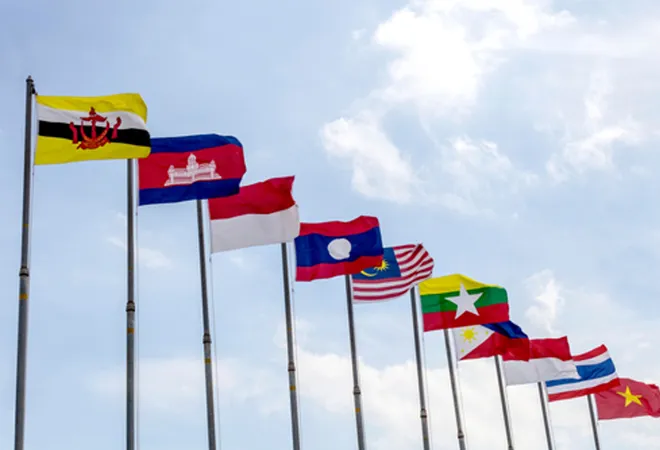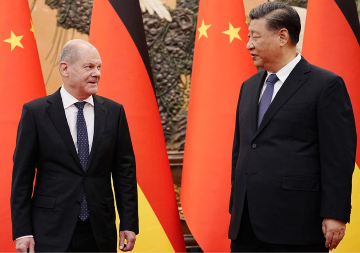< style="font-style: inherit;font-weight: inherit">Asia is home to an increasingly assertive China, whose questionable actions during the novel coronavirus pandemic have left countries in the region with an overwhelming sense of anger and frustration. Coupled with a dismal lack of responsibility and global leadership from the White House, nations in the region face uncertainty over Asia’s future in the post-COVID-19 era.
< style="font-style: inherit;font-weight: inherit">The good news is that Asia today has a growing number of economically and militarily capable middle powers like Japan, India, South Korea, and Singapore. But the deeper inclusion of prior outlier states like Hong Kong, Taiwan, and other ASEAN nations, will be important in bolstering further change. Unfortunately, this time around, the stakes are even higher than previously highlighted by a 2017 Asian Development Bank (ADB) report, which stated that developing Asia would need to invest $26 trillion between 2016 and 2030, or $1.7 trillion per year, in order for the region to maintain its growth momentum, eradicate poverty, and respond to climate change.
< style="font-style: inherit;font-weight: inherit">Although it remains too early to prognosticate the geopolitical consequences of COVID-19 for Asia, this essay aims to identify and examine the four most important, yet vulnerable areas requiring maximum attention following the pandemic.
< style="font-style: inherit;font-weight: inherit;color: #163449">Trade
< style="font-style: inherit;font-weight: inherit">The COVID-19 pandemic has served to emphasize the risk of China becoming the single most important nodal point in global and regional supply chains. China’s handling of the crisis has highlighted the unsustainable nature of the region's heavy dependence on one nation for its trade needs. In 2019 alone, eight of China’s top 15 trading partners were countries in Asia (nine, including Australia as part of the broader Indo-Pacific construct).
< style="font-style: inherit;font-weight: inherit">That said, pre-COVID-19 Asia showed glimpses of an Indo-Pacific economic architecture that could have healthy, reliable, and democratic states in the driving seat. For example, despite U.S. withdrawal, Japan was able to successfully progress the Trans-Pacific Partnership (TPP) in 2016. Japan has also been noted for playing a key role in lobbying for India's inclusion in the Regional Comprehensive Economic Partnership (RCEP). Though Japan is unlikely to convince India to re-join RCEP negotiations after India’s deadlock with China over its widening trade deficit, Japan’s lobbying role does demonstrate the economic unity and cooperation of key middle powers in the region.
< style="font-style: inherit;font-weight: inherit">The Indian economy is predicted to contract 0.9 percent by fiscal year 2021, and Japan officially entered recession for the first time in nearly five years. In an attempt to safeguard its citizens, several countries may begin to recoil from globalization. However, it is imperative for middle powers in Asia to fight this impulse to de-globalize. A positive externality of the crisis that has laid bare the urgency with which nations in the broader Asian region must act. Asia’s states must now try to strengthen their supply chains’ resistance to future shocks by engaging in regional diversification and by reducing supply chain redundancies, while also shortening the distance between said supply chains. Secondly, countries must aim to make expedited moves towards greater automatization.
< style="font-style: inherit;font-weight: inherit">Tokyo has already announced a $2.2 billion stimulus package to help Japanese companies move production lines out of China. Given South Asia’s availability of labor-intensive services, its young population, and a supportive policy environment, the region may be able to replace China as the world’s factory. Thus, Asian countries could look to move their supply chains to South Asia as the movement would also provide a renewed opportunity for enhanced Asian regional engagement and cooperation, for wealth building, and for enforcing the idea that regionalism can play a more significant role post-COVID-19.
< style="font-style: inherit;font-weight: inherit;color: #163449">Infrastructure and Connectivity
< style="font-style: inherit;font-weight: inherit">COVID-19 has exposed the weaknesses and risks that come with global interconnectedness which will, no doubt, have a long-lasting effect on many of the connectivity and infrastructure projects which are in various stages of completion across Asia. One of the most significant of these is China’s ambitious Belt and Road Initiative (BRI). As the world slips into a global recession, the question of continuing to fund the mammoth project arises, along with the future of the developing nations associated with it. As states battle the economic pressures of the pandemic, we must ask what will happen to the outstanding loans and projects that smaller states have already racked up?
< style="font-style: inherit;font-weight: inherit">China's debt-trap diplomacy, a term coined to capture China’s proclivity to saddle developing countries with unsustainable debt while increasing their dependence on China, has already been an important geopolitical issue. Sri Lanka, Pakistan, the Maldives, and most recently Kenya, have all been at the receiving end of this.
< style="font-style: inherit;font-weight: inherit">Post COVID-19 scenarios have begun to play out alongside these existing issues. We now see a China scrambling to secure, first and foremost, the needs of its Communist Party, and second, the economic needs of its citizens. Thus, it seems more than likely that international connectivity and infrastructure projects will be put on hold. Even if BRI projects are to pick up again, it will likely be a new BRI – an enterprise of a different complexion, led by possibly an even more confident China.
< style="font-style: inherit;font-weight: inherit">Thus, while we initially envisioned Asian infrastructure and connectivity projects as those which find themselves at the junction of competition and cooperation between China and other players, it might be time to re-think this position. Japan - which has decades of experience under its belt, is well known for its high standards, low yen loans, transparency, and willingness to cancel loans to smaller nations in need - could prove to be an important and reliable alternate to the China model post-pandemic.
< style="font-style: inherit;font-weight: inherit">For one, Japan could ensure that the ADB end its loans to China - which accounted for 12 percent of the bank’s contracts in 2018 – which is now at a point where it is no longer in need of financial aid. The ADB could instead begin re-allocating loans to smaller Asian states, such as ASEAN nations and South Asian states. This would not only be beneficial for the smaller regional states in dire need, but also help reset the tone of lending finance in the region as well as the quality and ethicality of project investments.
< style="font-style: inherit;font-weight: inherit">As alternatives to Chinese projects, countries like Japan and India could also step in and forge more collaborative connectivity and infrastructure projects with one another, as well as with other responsible middle powers in the region. While projects like the Asia Africa Growth Corridor have yet to see concrete results, the changing and slowing of BRI dynamics allows India and Japan to strengthen their engagement on joint infrastructure projects with the Indian Ocean region littoral states and across regional cooperation frameworks.
< style="font-style: inherit;font-weight: inherit;color: #163449">Maritime Security
< style="font-style: inherit;font-weight: inherit">Trends show that economic downturn goes hand in hand with an increase in illicit activities on trade routes and a spike in maritime crime. Further, the reduction in monitoring and enforcement capabilities in the high seas and by poorer governments in their territorial waters during the pandemic will only exacerbate operational security problems. Dryad Global indicated that a "partial increase" in piracy due to the virus is likely.
< style="font-style: inherit;font-weight: inherit">As we process this growing insecurity, we must do so keeping in mind that Asia has simultaneously witnessed China’s inability to slow down its territorial assertiveness at the height of the pandemic. In March, a Chinese fishing boat collided with a Japanese destroyer in the East China Sea. Days later, another collision took place as the Chinese coast guard reportedly sank a Vietnamese fishing boat near disputed territory in the South China Sea. Chinese fishing boats have also been reported striking a Taiwanese coast guard patrol vessel.
< style="font-style: inherit;font-weight: inherit">The pandemic-induced economic crisis will result in many nations rushing to reduce their defense budget and increase funding for COVID-19 relief programs and to cushion economic downturns. For example, South Korea has already reduced its defense budget and spending by 1.8 percent, or $733 million, and others may soon follow suit.
< style="font-style: inherit;font-weight: inherit">As these threats become a stark reality, middle powers in the region must work together to mitigate the disastrous effects that could ensue. When it comes to the Quadrilateral Security Dialogue (QUAD)—an initiative to facilitate conversation and cooperation between the U.S., Japan, Australia, and India, in the context of China’s rise—Japan and India share a vision of inclusivity and regional engagement. Institutionalizing the QUAD would give it the heft to become a more effective mechanism to combat increasing maritime threats emerging from the pandemic. As we witness the potential decoupling of U.S.-China ties, the crisis presents an opportunity to expand the grouping into the QUAD plus one, or SQUAD (Singapore plus the QUAD) increasing representation of key regional middle powers.
< style="font-style: inherit;font-weight: inherit">For its part, India, which maintains a complex relationship with China, has been extremely skeptical of China’s management throughout the pandemic. This, in turn, has reinforced the importance of India playing a larger role in the region as the net security provider. The country has already taken steps to enhance its perception as a reliable leader in its neighborhood by swiftly providing humanitarian aid to Bangladesh, Nepal, Bhutan, Afghanistan, Maldives, Seychelles & Mauritius and setting up a $10 million emergency fund for SAARC nations. India should further amplify its perception of reliability, while enhancing cooperation with Asian nations like Japan and ASEAN to share information, build trust, and build maritime domain awareness in the Indian Ocean for enhanced security from maritime threats in the waters of Asia.
< style="font-style: inherit;font-weight: inherit;color: #163449">Multilateralism
< style="font-style: inherit;font-weight: inherit">Mismanagement of the virus has forced us to confront certain grim realities when it comes to the role of international institutions in global governance. The World Health Organization (WHO) toed the official line of Chinese authorities when the country made initial attempts to repress news of the virus, thus waiting too long to sound the warning bells of COVID-19. This has been followed by Chinese attempts at mask diplomacy, and sending medical help to a large number of countries, instead of being held accountable by international institutions for its actions.
< style="font-style: inherit;font-weight: inherit">That said, the U.S. also failed to lead international efforts against COVID-19. At the peak of the crisis, President Trump announced that the U.S. would withdraw funding to the WHO, drawing significant global criticism. If China and the U.S. are going to risk turning multilateralism into an 'America first' narrative, butting heads with China, it is imperative for the future of the region to be reenvisioned and recalibrated.
< style="font-style: inherit;font-weight: inherit">A closer look at Taiwan and Hong Kong, and their key role in reducing the number of COVID-19 cases, is testament to the steep learning curve from the 2003 SARS pandemic. This experience should bring to light an overlooked part of Asian leadership – that which is resilient, responsible, and capable in the midst of a crisis. By openly recognizing Taiwan’s contribution to the fight against the virus, both Prime Minister Shinzo Abe and European Commission President Ursula von der Leyen have paved the way for dialogue that should aim to eventually see Taiwan regain observer status in the World Health Assembly, and possibly more.
< style="font-style: inherit;font-weight: inherit">However, it is important for other middle powers in the region to follow suit. India, for instance, would be a good starting point. In fact, the recent interview with Taiwanese Ambassador Chung-Kwang Tien is a testament to Taiwan's will to support India's fight against the virus.
< style="font-style: inherit;font-weight: inherit">Finally, despite being at a critical junction, the EU which has long been known for its affinity to multilateral institutions, can become an increasingly important partner for Asian countries. In April 2020, the EU even mobilized $ 380 million in aid to support ASEAN countries in their fight against COVID-19. The EU has also been an avid funder of multiple development programs through its various sub-regions of South Asia, East Asia, and Southeast Asia. In this time of crisis and during a vacuum left by U.S. and Chinese shortcomings, it may be wise to consider a greater role for the EU in Asia. This could take shape in the form of trilateral cooperation – for instance, an India-Japan-EU trilateral or an EU-Japan-ASEAN trilateral.
< style="font-style: inherit;font-weight: inherit">The pandemic has exposed risks and vulnerabilities that have accrued in Asia, leaving the region’s states with more questions than answers. Despite Asia’s middle powers not being great powers, a coalition between them, encouraged and invested in over time, carries with it the potential to give Asian regionalism renewed hope – one that can withstand being pulled down by the egocentric and irresponsible actions of both the U.S. and China, and their deepening rivalry.< style="font-style: inherit;font-weight: inherit">
This article was first published in Journal of International Affairs, Columbia University
The views expressed above belong to the author(s). ORF research and analyses now available on Telegram! Click here to access our curated content — blogs, longforms and interviews.




 PREV
PREV



